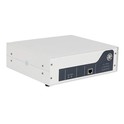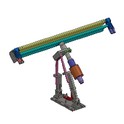Ultrasonic assisted machining (UAM) has emerged as a game - changer in the manufacturing industry. As a supplier of UAM equipment, I've seen firsthand how this technology can significantly enhance machining processes. However, like any technology, it's not without its limitations. In this blog, I'll break down some of the key limitations of ultrasonic assisted machining that you should be aware of.
High Initial Investment
One of the most significant limitations of UAM is the high initial investment required. Setting up an ultrasonic assisted machining system isn't cheap. You need to purchase specialized equipment, including ultrasonic generators, transducers, and the vibration tables themselves. For example, our ResoTab - P20 Ultrasonic Vibration Tables, ResoTab - F20 Ultrasonic Vibration Tables, and ResoTab - P30 Ultrasonic Vibration Tables are state - of - the - art products, but they come with a price tag.
These costs can be a major deterrent for small and medium - sized enterprises (SMEs) that are looking to adopt UAM. They might not have the capital to invest in such advanced equipment, even though they could potentially benefit from it in the long run. And it's not just the cost of the hardware. There are also installation costs, as well as the need for specialized training for operators. All these factors add up and make it difficult for some businesses to take the plunge into UAM.
Limited Material Compatibility
Another limitation is the limited material compatibility of ultrasonic assisted machining. UAM works best with certain types of materials, such as brittle materials like ceramics and glass. The ultrasonic vibrations help to break the material in a more controlled manner, reducing the chances of cracking and improving the surface finish.
However, when it comes to ductile materials like some metals, the effectiveness of UAM is somewhat reduced. The ultrasonic vibrations may not have the same impact on these materials, and in some cases, they might even cause problems. For example, the vibrations could lead to work hardening in the material, which can actually make it more difficult to machine. This means that if you're working with a wide range of materials in your manufacturing process, UAM might not be the one - size - fits - all solution you're looking for.
Complex System Setup and Maintenance
Setting up an ultrasonic assisted machining system is no walk in the park. It requires a high level of technical expertise. You need to carefully calibrate the ultrasonic generator, transducer, and the vibration table to ensure that they work together seamlessly. Any small miscalibration can lead to sub - optimal performance, such as inconsistent vibration amplitudes or frequencies.
Maintenance is also a challenge. The ultrasonic components are delicate and need to be regularly inspected and maintained. The transducers, for example, can wear out over time, and they need to be replaced periodically. This not only adds to the cost but also requires downtime in the manufacturing process. You can't just keep running the system without proper maintenance, or you'll end up with poor - quality parts and potential equipment failures.
Noise and Vibration Issues
Let's talk about the noise and vibration issues associated with UAM. The ultrasonic vibrations, as the name suggests, generate a significant amount of noise. This can be a major problem in the workplace, especially if there are no proper noise - reduction measures in place. Prolonged exposure to high - level noise can lead to hearing problems for the operators.
In addition to the noise, the vibrations can also affect the surrounding environment. They can cause vibrations in other nearby equipment, which might interfere with their normal operation. This means that you need to carefully plan the layout of your manufacturing facility to isolate the UAM system from other sensitive equipment.
Process Control Challenges
Controlling the ultrasonic assisted machining process is complex. There are multiple variables that need to be monitored and adjusted in real - time, such as the ultrasonic power, frequency, and the feed rate of the machining tool. These variables are interdependent, and changing one can have a significant impact on the others.
For example, increasing the ultrasonic power might improve the material removal rate, but it could also lead to an increase in tool wear. Maintaining the right balance between these variables to achieve the desired machining results is a constant challenge. It requires skilled operators who are well - trained in understanding and adjusting these parameters.
Lack of Standardization
There is currently a lack of standardization in the ultrasonic assisted machining industry. Different manufacturers might use different specifications and parameters for their UAM systems. This makes it difficult for customers to compare different products and make informed decisions.
For example, the way one manufacturer defines the vibration amplitude or frequency might be different from another. This lack of standardization also makes it challenging to develop universal best practices for UAM. Without clear standards, it's hard to ensure consistent quality across different manufacturing facilities that use UAM.
Higher Energy Consumption
Compared to traditional machining methods, ultrasonic assisted machining generally consumes more energy. The ultrasonic generator needs to supply a continuous stream of power to generate the vibrations. This higher energy consumption not only increases the operating cost but also has environmental implications.
In today's world, where there is a growing emphasis on sustainable manufacturing, the high energy consumption of UAM can be a drawback. Manufacturers are constantly looking for ways to reduce their carbon footprint, and the energy - intensive nature of UAM might make it less attractive in this regard.
Conclusion
Despite these limitations, ultrasonic assisted machining still offers many benefits, such as improved surface finish, reduced tool wear in some cases, and the ability to machine difficult - to - cut materials. As a supplier, we're constantly working on improving our products to overcome these limitations. We're researching new ways to make the system more user - friendly, reduce the cost, and improve the material compatibility.
If you're considering adopting ultrasonic assisted machining in your manufacturing process, it's important to weigh the pros and cons carefully. If you think UAM could be a good fit for your business, despite the limitations, we'd love to talk to you. We can provide you with more information about our products and help you find the best solution for your specific needs. Feel free to reach out to us to start a conversation about procurement and see how we can work together to take your manufacturing to the next level.


References
- Dornfeld, D., & Min, S. (2003). Ultrasonic Vibration–Assisted Machining. CIRP Annals - Manufacturing Technology, 52(2), 521 - 542.
- Klocke, F., & Eisenblätter, G. (1997). Machining of Advanced Ceramics. CIRP Annals - Manufacturing Technology, 46(2), 587 - 606.
- Guo, N., & Rahmani, M. (2016). Recent advances in ultrasonic vibration - assisted machining. International Journal of Machine Tools and Manufacture, 103, 10 - 24.




